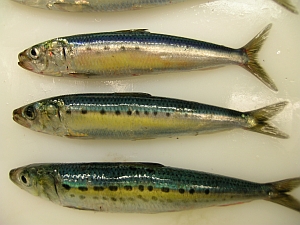A task force of 13 environmental and marine researchers from North America, Australia, Europe, and South Africa recommends reducing the global catch of herring, anchovy, and other forage fish to maintain the ocean ecosystem and sustain supplies of larger commercial species. A report from the Lenfest Forage Fish Task Force, based at Stony Brook University in New York, estimates that the value of forage fish species in the ocean is more than double the value of their direct catch.
The task force led by Ellen Pikitch, professor of ocean conservation science at Stony Brook, conducted two computer simulations of marine food ecosystems using standard modeling software for marine science. One simulation used 72 published models to quantify the value of forage fish as a commodity and as food for other commercially fished species. The second simulation used dynamic models to test the impact of various fishing strategies on forage fish and their predators. The researchers also examined in first-hand case studies the sand eel, Peruvian anchoveta, capelin, Atlantic menhaden, and Pacific sardine.
A thriving marine ecosystem, says the report, relies on these small schooling fish that eat tiny plants and animals, called plankton, and are preyed upon by animals such as penguins, whales, seals, puffins, and dolphins. They are primary food sources for many commercially and recreationally valuable fish found around North America, such as salmon, tuna, striped bass, and cod.
The demand for forage fish has grown in recent years for use in agriculture and human nutrition, as fish meal and fish oil to feed farmed fish, pigs, and chickens, as well as in nutritional supplements. The task force estimates that forage fish are twice as valuable in the water as in a net, contributing $11.3 billion worldwide by serving as food for other commercially important fish, more than double the $5.6 billion they generate as direct catch. The researchers peg the total economic value of forage fish at $16.9 billion.
The task force concludes that conventional management strategies, based on maximum sustainable yields, are too risky and can lead to depleting of stocks needed to maintain food supplies for predators that feed on forage species. “As three-fourths of marine ecosystems in our study have predators highly dependent on forage fish,” says Pikitch, “it is economically and biologically imperative that we develop smarter management for these small but significant species.”
The report recommends developing more precautionary catch strategies aimed at preventing a decline in the natural predators. The group’s simulations indicate that limiting catches to half of the current conventional levels would lessened declines in dependent predators and reduced the likelihood of forage fish collapses. Task force member Dee Boersma at University of Washington says, ” “Our hope is that fishery managers will put our recommendations into action to protect penguins, cod, whales, and a whole host of other creatures that need them to survive.”
Read more:
- Environmental Issues Changing Atlantic Mackerel Distribution
- Community Management Can Sustain Small Fisheries
* * *


 RSS - Posts
RSS - Posts
[…] Study Urges Deep Cut in Forage Fish Catch […]
[…] Study Urges Deep Cut in Forage Fish Catch […]